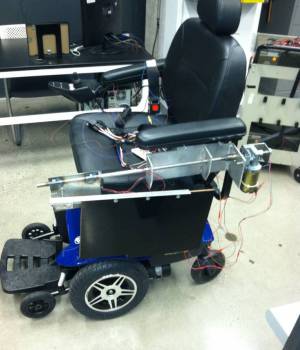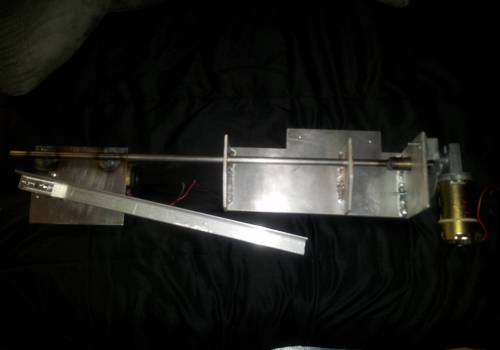EID101 - Assistive Devices
Quick Summary
This class involved working in groups on projects to help improve a wheelchair user's experience. My group consisted of myself, Anthony Traina, Daniel Fagan, and Alexander Serrano. We worked on creating a motorized desk that was easily accessible to a wheelchair user. Through the use of two motors to achieve motion in two planes, welding of metal materials, and electronics to move the desk by button command, we had a final product that largely served it's initial purpose.
Mechanical Description
Our project relied on motion in two planes: motion to rotate the desk up from hanging and another motion for rotating the desk onto the lap of the user. The design that was implemented to achieve these two motions is an assembly consisting of two motors. The assembly hangs on the side of the armrest, fastened using two already pre-made holes in the armrest. The main body of the device consists of an aluminum plate that was plasma cut to fit the armrest. Three brackets, also plasma cut, were welded onto this main body. These brackets were used to support the device and allow the assembly to rotate. At the back end of the device in reference to the wheelchair, a motor was bolted on to the last bracket. This motor’s shaft was held tightly using set screws inside a custom-made coupler. The coupler was then welded to the steel rod, which is the main shaft of the device. This motor-assembly allows for the rotation of the entire assembly in order to place the desk onto the lap of the user. At the other end of the steel rod, a steel plate was welded to the rod so another motor could be bolted onto it. A hole was made through this plate as well to allow the motor’s shaft to go through it. This motor’s shaft is held tightly inside another custom-made coupler using set screws. This coupler is bolted to an aluminum angle in which the desk is bolted to. This motor-assembly allows for rotation of the desk in the plane in which it was hanging from the armrest.
Pictures
Except where otherwise noted, content on this wiki is licensed under the following license:CC Attribution-Noncommercial-Share Alike 3.0 Unported

